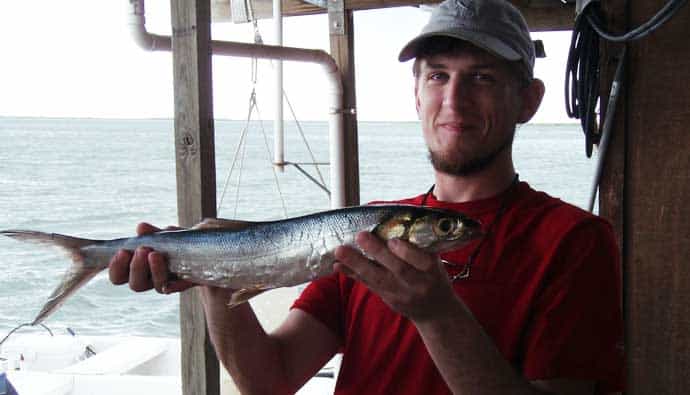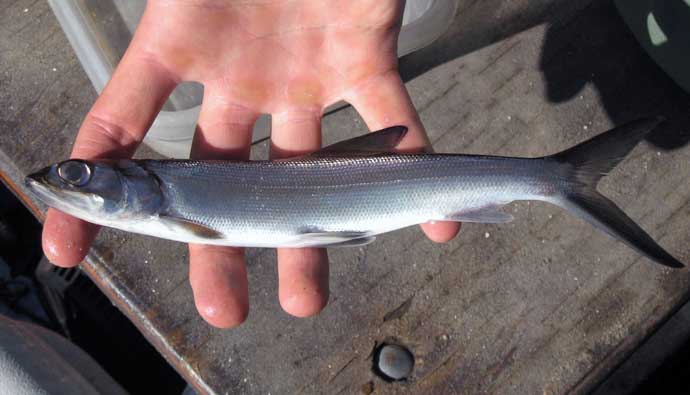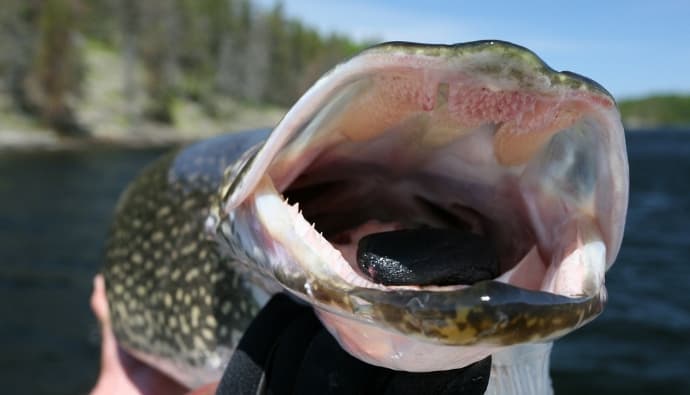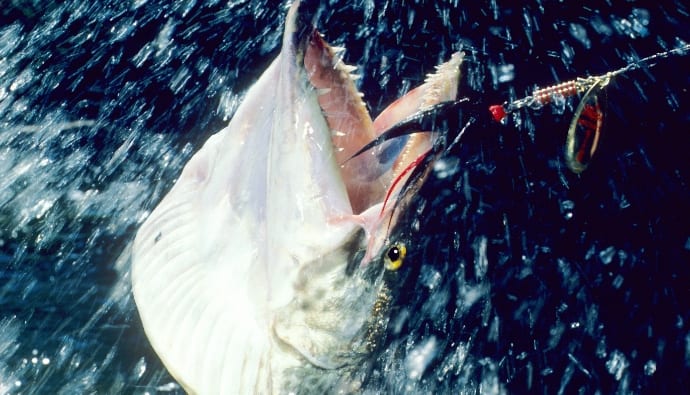My guess is that you’re not going to head out on the water for the day just to catch ladyfish Elops saurus.
Anglers often ask, can you eat ladyfish? Just check out some of the YouTube videos and you’ll see why most people would rather spit it out than throw it down the hatch.

However, if you do want to catch one of these fish, here’s how we recommend you do it.
Recommended Fishing Gear:
- Rod: St. Croix Mojo Inshore Spinning
- Reel: Penn Battle III
- Lure: MirrOLure Mirrodine
Overview
Also known as skipjack fish, long john, bonyfish, fiddler, elopid, banana fish, and ten-pounder, the ladyfish has a long, slender, and elongated body with a compact oval cross-section and a deeply forked tail. The head is pointed, and it has a large mouth and eyes. Ladyfish are tolerant of brackish water and can grow to about 3 feet long and weigh about 15 pounds.
Ladyfish occur in the western North Atlantic Ocean from Cape Cod, Massachusetts, to the Gulf of Mexico and the Caribbean Sea. It can also be found in waters around Bermuda. It feeds on smaller fish and crustaceans once it grows old enough.
Ladyfish Facts
| Scientific Name | Elops saurus |
| Common Name(s) | Ladyfish |
| Family | Elopidae |
| Identifying Characteristics | Has a long, slender, and elongated body with a compact oval cross-section and a deeply forked tail. The head is pointed, and it has a large mouth and eyes |
| Depth Range | 0 to 50 m |
| Habitat | Occurs in the western North Atlantic Ocean from Cape Cod, Massachusetts, to the Gulf of Mexico and the Caribbean Sea |
| Limits | Check your local regulations |
| Largest Recorded | 15 lbs |
Where to Catch Ladyfish
The lady fish can be found in brackish water lagoons, bays, and mangroves and can withstand a range of salinities. Some have also been known to be found several miles offshore. The fish prefers open waters in channels that experience moderate currents as well as shallow bars and eddies at the bends in rivers. It can also tolerate low temperatures for short periods.
How to Catch Ladyfish

Known as the poor man’s tarpon, ladyfish Elops saurus is not often sought after, but its fighting strength and jumping ability make it a good sports fish. Use spoons to search for them. These are easy to throw and are preferred by the fish since they love to chase and swallow fish whole.
For live or dead bait, use the fish’s favorite prey, such as mullet, anchovies, sardines, and menhaden, as well as shrimp and crustaceans. The biggest ones will be a challenge to catch, so use a fast-action spinning rod that is about 7 feet in length.
If you are using live bait, use a medium-action rod instead. The extra flexibility and whip will keep the live bait from getting ripped off. Plus, if you are using lures, make sure it is moving at a fast pace, or the ladyfish will ignore it.
Once you’ve caught ladyfish, be very careful when you are handling it. It has sharp sets of tiny teeth that can penetrate the skin and cause injuries. Unhook the fish using special fish pliers while holding around the fins to prevent a nasty cut, and make sure you have strong gloves on as well.
Plus, be ready to mop up muddy poop that ladyfish will spray on the deck once it is brought on board. A mixture of liquid detergent and a cup of white vinegar will wash those stains right out.

Fishing Tactics
- These bony fish are usually in shallow water, so you will see some surface action if you are within 30 ft where big ones congregate. They will follow small baits to the surface, but if you want to find them, watch for birds on the water that are feeding on baitfish.
- Catching ladyfish can be a lot of fun if you use a light setup; the lighter, the better. A good 4 to 6-pound test reel will do matched with a light 6-foot rod, especially if you are targeting juveniles.
- The skipjack fish will readily hit small silvery streamer flies and popping surface flies. Flyfish for them in backwaters since those are protected by the wind. A good 2 to 4-weight rod will allow you to cast far and have fun at the same time.
Fishing Tips
- The fluorocarbon leader is the best one to catch ladyfish. It’s the only one that cannot be cut easily by the fish’s razor-sharp teeth. Invest in a 10 to 15-pound test one that is connected to a braided or monofilament line.
- If you would like more freedom while fishing, combine the leader with the monofilament line.
- The best lure to use to catch ladyfish is the silver spoon. That and a shallow diving plug will mimic mullet, which is one of its favorite prey.
Seasons
Ladyfish can be found year-round, but the location varies according to season. In spring, the fish is dispersed throughout estuaries and bays that have modest salinity. In summer, the fish will keep away from the harsh sun in deeper waters and shallow waters when it goes down or early in the morning.
During this time, look for ladyfish in backwaters in between grass, where they will be looking for food to prepare for the spawning season. Similarly, during fall, the skipjack fish adults move offshore for some time to feed before spawning; the same is the case in winter.
Frequently Asked Questions
No, it isn’t one of the best fish to eat but it is fun to catch. There is a reason why you won’t find many ladyfish recipes online. It does not taste good and is considered a trash table fish.
This fish rivals mullet as one of the best baitfish and is taken dead or alive by trout.
Juveniles forage for zooplankton, and adults go after small fish, mullet, shrimp, and crustaceans.
The three best ways to catch ladyfish in the surf are to use a chartreuse lure, cut bait, or live shrimp.
Insider Advice
The ladyfish is not good to eat, but owing to its strong fighting abilities, it is a great sports fish, so you won’t waste a day out on the water. Even if you don’t release them, you can always cut them for cut bait or chum to attract larger fish.
Don’t confuse it with the tarpon, though. This fish has a trailing filament on the back edge of the dorsal fin, a feature that is absent in the ladyfish.




 Facebook
Facebook YouTube
YouTube









